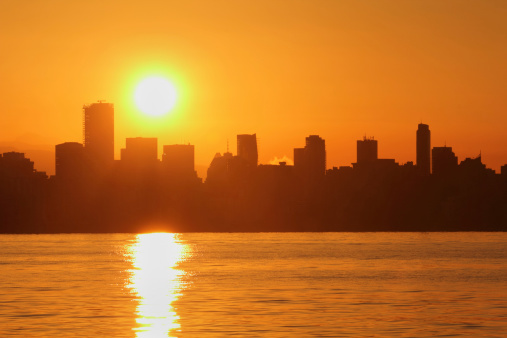Climate Change Weekly #148
Climate tweet of the week from economist Richard Tol:
“The US-China climate deal is a model for world diplomacy: too small to fail”
Mid-November 2014 has been a time of record-setting temperatures and snowfall. Hardly anyone in the United States can avoid it, and even if your locale hasn’t experienced record cold itself, somewhere in your region has. This is not how global warming is supposed to work.
The United States has experienced an unusual amount of record-breaking cold weather and weather-related phenomena in 2014. Early in the year, in large part due to the polar vortex, hundreds, if not thousands, of American cities and towns experienced multiple days of record-setting temperatures – both record lows and record-low high temperatures.
This odd weather continued into the summer. In July, record lows or record-low high temperatures were set in cities across the nation, including in Atlanta, Baltimore, Dallas, and Pittsburgh, as well as in states from Minnesota to Alabama and Florida. The streak continued into September, when 246 record-low high temperature records were broken or tied between September 1 and September 10 alone.
Jacksonville, Florida recently joined hundreds of other cities in the nation that have, since November 10, witnessed record lows – a low of 24 degrees broke the 141-year-old mark for November 20 by six degrees.
Weather Bell Analytics reports:
An astounding 226 million Americans will experience at or below freezing temperatures (32°F) on Tuesday as well – if you venture outdoors.
More than 85% of the surface area of the Lower 48 reached or fell below freezing Tuesday morning. All 50 states saw at or below freezing temperatures on Tuesday.
Record lows from Idaho to Nebraska and Iowa south to Texas and east through the Great Lakes, the eastern 2/3 of the US will shatter decades-long and in some cases, century-long records. Temperatures east of the Rockies will be 20–40°F below climate normals.
Compared to normal, temperatures over the past several days have dropped off a cliff – to 10°C below climate normal – more anomalous than even during the polar vortex of early January.
And Boston.com reported 1,360 cities and towns set daily-low maximum records over the past week.
On one night in mid-November, every state in the nation, including Florida, Hawaii, and Texas, had one or more locations reporting at or below freezing temperatures, and 85 percent of the nation saw freezing temperatures. This is mid-November, not mid-winter.
And let’s not forget about snowfall. Buffalo, among other Great Lakes region cities, is experiencing “Snowpocalypse,” a phrase I’m copywriting if possible. More than six feet of snow fell in Buffalo in less than 48 hours, with three or more feet threatening to fall by the end of the week. This is more than the city typically gets annually.
By November 3, areas in Maine, which typically accumulate less than a foot of snow for the entire month of November, had already received two feet of snow. Not to be outdone, on November 1, South Carolina experienced its earliest snowfall since official records began in 1886. The previous earliest snowfall recorded was on November 9, 1913.
Indeed, snow currently covers more than 50 percent of the country, more than twice the coverage the United States usually experiences for mid-November.
The records keep falling and climate models keep getting it wrong.
SOURCES: CNN.com; Weatherbell.com; Boston.com; Polar Bear Science.com
HALT LOW-CARBON FUNDING
The Global Warming Policy Forum (GWPF) has called for the United Kingdom to cease promoting and funding low-carbon-dioxide-emitting technologies with its international climate finance contributions. The GWPF would prefer to see the United Kingdom dedicate the funds to help developing countries take adaptive measures. The government has previously spent £3.87 billion of taxpayer money on international climate finance, with more than half of this funding allocated to low-carbon energy development, while approximately a quarter has been used for adaptation. By some estimates, of the $35 billion of global international climate aid given from 2010–12, less than 15 percent was allocated to measures helping poor nations adapt or respond to climate change. In calling for a shift in priorities, Dr. Benny Peiser, director of GWPF stated, “The UK’s contribution to international climate finance should be targeted at helping the developing world become more resilient instead of making energy more expensive for developing economies.”
SOURCE: Global Warming Policy Foundation
EU PARLIAMENT MEMBER’S CLIMATE DISSENT
Roger Helmer, UK representative to the European Union Parliament, has examined the EU’s preliminary proposal to create a $10 billion fund to help developing countries deal with “the effects of climate change,” and he found it lacking. Helmer argues the fund is unnecessary, because the science underpinning climate alarmism is highly speculative since the climate models are continually confounded by actual temperature readings and climate phenomena. He also believes the fund will be ineffectual because coal is the fastest-growing energy source, thus global greenhouse gas emissions will rise regardless of the money spent. In addition, Helmer stated the fund will be “ruinously expensive” because the renewable energy technologies on which the money will be spent aren’t and may never be competitive with fossil fuels.
SOURCE: The American Thinker
 |
COAL: FASTEST-GROWING ENERGY SOURCE
Based on the amount of power produced, coal has been the world’s fastest-growing energy source for a decade. BP’s “Statistical Review of World Energy 2014” shows from 2003 to 2013, coal use increased more than any other source of energy in every year except 2008. Until recently, coal’s growth has largely been driven by China. Excluding China, natural gas saw the fastest growth, but in 2013, even excluding China, coal was the fastest-growing source of energy. In 2013, coal use rebounded in the United States after a weak 2012. While coal saw a resurgence in Europe in 2012, it declined in 2013. Remove the United States and Europe from the data, and coal is still the fastest-growing energy source because of enormous growth in India. As a result, policies focused on reducing coal use in China will have little effect on greenhouse gas levels, because India and other developing countries are increasingly turning to inexpensive, reliable coal for electric power generation.
SOURCE: Council on Foreign Relations
ANCIENT MAMMALS DEFY CLIMATE MODELS
Climate alarmists claim global warming will cause an increasing number of species to go extinct because they are unable to adapt to habitat changes. While alarmists have been unable to identify a single species that has gone extinct because of climate change thus far, they still raise alarms based on the projections of ecological niche models and hindcasting to predict past animal and plant habitats. Recent fossil finds suggest ecological niche models and their hindcasting efforts are every bit as flawed as climate models. University of Oregon geologist Edward B. Davis and his colleagues examined the fossil records of five ancient mammalian species that survived the last ice age: the now extinct short-tailed shrew, the American marten, two species of flying squirrels, and the Gapper’s red-backed vole. Each of the species lived outside of ranges predicted by the models, and only small numbers of a couple of the species lived in the ranges the models predicted.
SOURCE: Watts Up With That.com
VOLCANIC ERUPTIONS LINKED TO TEMPERATURE LULL?
Another fanciful theory in a string of theories has cropped up to explain the lull in global warming: This time the culprit suppressing global average temperature is small volcanic eruptions. A new study accepted for publication in the American Geophysical Union’s, Geophysical Research Letters suggests small volcanic eruptions eject more atmosphere-cooling sulfuric acid particles into Earth’s atmosphere than previously thought, potentially contributing to the recent slowdown in global warming. These eruptions are not accounted for in most climate models. New ground, air, and satellite measurements show small volcanic eruptions between 2000 and 2013 have deflected almost double the amount of solar radiation previously estimated. As a result, these recent eruptions could be responsible for decreasing global temperatures by 0.05 to 0.12 degrees Celsius (0.09 to 0.22 degrees Fahrenheit) since 2000. While the results of the study should be confirmed and it may prove to be a partial explanation for the ongoing hiatus in rising temperatures, my question is this: Except for an anomalous year in 2013, about 50 to 70 volcanoes are active and erupt each year (some almost continuously). If 50 to 70 eruptions occurred on average during the temperature pause, and 50 to 70 eruptions occurred on average before the pause, isn’t the temperature suppression a wash? Why would the eruptions during the pause have a different effect on global temperatures than before the pause? Either small volcanic eruptions suppress global temperatures or they don’t, but if they do, they likely have the same effect on temperature regardless of the time period chosen.
SOURCE: Watts Up With That.com





